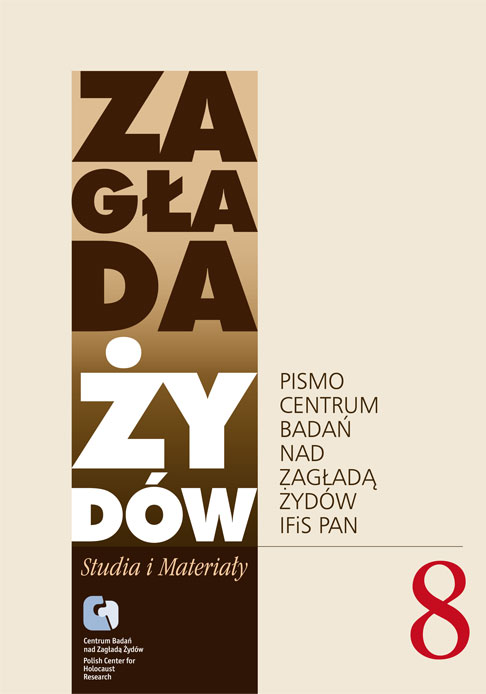Odmienne sylwetki przybyłych do Szwecji więźniów pochodzenia żydowskiego i nieżydowskiego, ocalałych z obozów koncentracyjnych na ziemiach polskich
Zagłada Żydów. Studia i Materiały, Nr 8 (2012), Strony: 419-429
Data zgłoszenia: 2020-12-06Data publikacji: 2012-12-02
 https://doi.org/10.32927/zzsim.698
https://doi.org/10.32927/zzsim.698
Abstrakt
Survivors from Nazi concentration camps, who were brought to Sweden as refugees during the last month of the Second World War and during the summer that followed, were often required to supply information about personal details to the authorities. Much of the information was later stored in written form in the Swedish National Archives. Antisemitism among the refugees and enmity between the Jewish and non-Jewish Polish refugees caused the authorities to include their ethnic or religious affiliation in many records and documents. Using mainly two collections from the Swedish National Archives it is shown that substantial differences existed between Jewish and non-Jewish Polish refugees with respect to their age, education and the length of their war experiences. These differences, in addition to the existing socio-geographic, demographic, cultural and ethnic differences led to inevitable clashes between the two groups. The Swedish authorities who first regarded all refugees of Polish citizenship as one national group had to revise this attitude gradually during the administration of the refugees
Słowa kluczowe
ocalali z Zagłady , Szwecja , stosunki polsko-żydowskie
Licencja
Prawa autorskie (c) 2012 Autor & "Zagłada Żydów. Studia i Materiały"

Utwór dostępny jest na licencji Creative Commons Uznanie autorstwa 4.0 Międzynarodowe.
https://creativecommons.org/licenses/by/4.0
Podobne artykuły
- Redakcja Czasopisma, Nagroda im. Israela Gutmana dla Karoliny Panz , Zagłada Żydów. Studia i Materiały: Nr 12 (2016)
- Jakub Petelewicz, „Kresy Wschodnie pod okupacją sowiecką 1939–1941; stosunki ukraińsko-polsko-żydowskie, życie społeczne i wzajemne relacje” , Zagłada Żydów. Studia i Materiały: Nr 3 (2007)
- Havi Dreifuss, Badania nad życiem religijnym Żydów w Polsce podczas Zagłady – główne źródła i podstawowe zagadnienia , Zagłada Żydów. Studia i Materiały: Nr 9 (2013)
- Andrzej Grzegorczyk, Procedura i przebieg transportów kolejowych z getta łódzkiego do obozu zagłady w Chełmnie nad Nerem (styczeń–maj 1942 r.) , Zagłada Żydów. Studia i Materiały: Nr 16 (2020)
- Dariusz Libionka, Jacek Leociak, 75. rocznica akcji „Reinhardt” , Zagłada Żydów. Studia i Materiały: Nr 13 (2017)
- Andrzej Żbikowski, Lidia Zessin-Jurek, Katharina Friedla (red.), Syberiada Żydów polskich. Losy uchodźców z Zagłady [Andrzej Żbikowski] , Zagłada Żydów. Studia i Materiały: Nr 17 (2021)
- Jan Grabowski, Lea Balint, Dziennik Hindy i Chaniny Malachi , Zagłada Żydów. Studia i Materiały: Nr 3 (2007)
- Jacek Leociak, Zagłada w „Muzeum życia” (Muzeum Polin i jego kłopoty z muranowskim genius loci) , Zagłada Żydów. Studia i Materiały: Nr 11 (2015)
- Bartłomiej Krupa, Critical History and its ‘Shadow Cabinet’. Polish Historiography and the Holocaust during 2003–2013 , Zagłada Żydów. Studia i Materiały: Nr Holocaust Studies and Materials (2017)
- Jan Grabowski, Lea Balint, The Diary of Hinda and Chanina Malachi , Zagłada Żydów. Studia i Materiały: 2008: Holocaust Studies and Materials
<< < 1 2 3 4 5 6 7 8 9 10 11 12 13 14 15 16 17 18 19 20 21 22 23 24 25 26 27 28 29 30 31 32 33 34 35 36 37 38 39 40 41 42 > >>
Możesz również Rozpocznij zaawansowane wyszukiwanie podobieństw dla tego artykułu.
 English
English
 Język Polski
Język Polski








